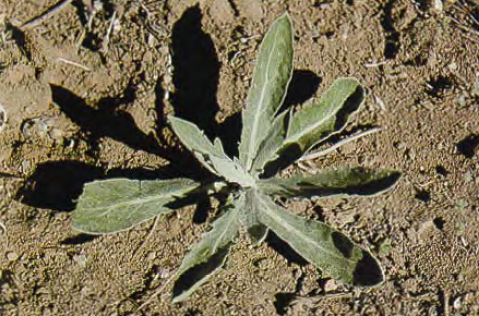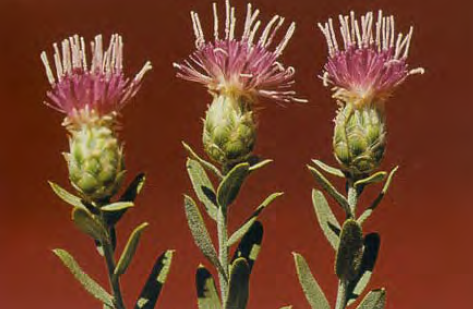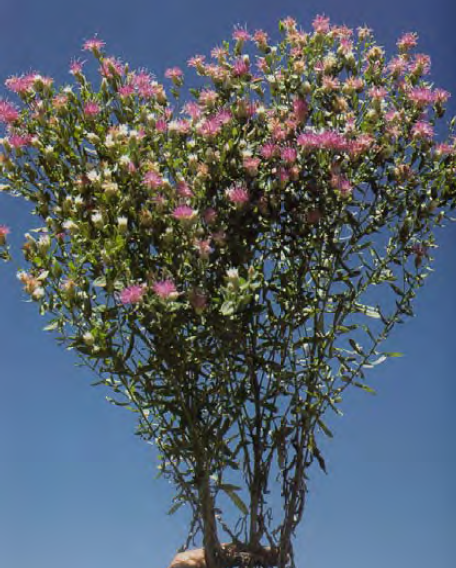Introduction
Russian knapweed (Acroptilon repens) is a nonnative, noxious and invasive weed that is extremely difficult and expensive to control once it becomes established. It is found in almost every county in Nevada. From a survey in 2000, it was estimated that Russian knapweed had infested 75,000 acres in Nevada.
Identification
Russian knapweed, a member of the Asteraceae (Aster) family, is native to Eurasia. It is a perennial herb with erect stems that grow 18 to 36 inches tall with many branches. The rosette leaves are narrow at the base and widen toward the tip (Fig.1). The lower leaves on the stems are two to four inches long, toothed, and deeply lobed. The smaller, upper leaves usually have smooth margins, and are attached to the stem without a stalk at their base. The stems and leaves are covered with fine, gray hairs.

Figure 1. Leaves of newly emerging plants are toothed and covered with fine hair.
Flowers are urn-shaped and occur singly on shoot tips from June to September. They are about ¼ to ½ inch in diameter, and pink to purple in color (Fig. 2). Surrounding the base of the flower are green bracts that have light, thin hairs. Each bract has a papery tip. These characteristics of the bracts help distinguish Russian knapweed from the other knapweeds generally found in the Western United States.
The flat Russian knapweed seed is a smooth, ivory-colored achene. The seeds develop in late summer and are viable in the soil for at least two to three years. Russian knapweed does not produce as many seeds as most other invasive weeds, but it readily reproduces vegetatively.
Russian knapweed produces extensive vertical and horizontal roots. The roots penetrate the soil several meters deep. Its scaly, black to brown, underground stems (rhizomes) have buds that develop into new shoots and quickly colonize nearby areas. Small root pieces created by plowing, rototilling, or other soil disturbances can generate new shoots and spread this weed.

Figure 2. Russian knapweed flowers are pinkish purple, and the bracts have papery tips.
Habitat
Russian knapweed is widely established in the western United States. Highly adaptable, it occurs in most soil types. Abundant in both moist and arid climates, Russian knapweed only becomes established in moist soils in arid areas and not in upland sites where water tables are deep. It is a strong competitor and forms dense colonies, even monocultures, especially in disturbed areas, such as roadsides, riverbanks, pastures, and cropland.
In Nevada, Russian knapweed is a problem in crop and rangelands. In addition, it is often found around old buildings and growing on disturbed ground. This weed prefers moist but not wet sites, such as drainages, riparian zones that are not excessively wet including ephemeral stream and pond bottoms, irrigated fields, and runoff areas that periodically dry down. Once established, Russian knapweed is very tolerant of drought conditions and is a great competitor because its deep, extensive roots draw moisture from a greater volume of soil compared to shallow rooted species. Its deep rootedness allows it to survive dry surface soils for long periods.
Threat
Russian knapweed is a designated noxious weed in Nevada. When established, it forms dense, single-species stands because its roots exude substances that reduce or prevent the growth of nearby plants (allelopathy). This eliminates desirable plants, including natives, and greatly reduces crop production.
Russian knapweed seeds are small and difficult to separate from most small crop seeds. Consequently, it is frequently spread as a contaminant of crop seed and hay. Being a nutritionally poor feed and toxic to horses, its presence in hay decreases the hay’s value and thus, its market price.
Dispersal of Russian knapweed today occurs from seed and roots. Seed is spread mostly through contaminated hay, farm machinery and all types of vehicles, including recreational vehicles. At one time, it was recommended for seeding to control erosion, which allowed it to become widespread. Seed production distributes Russian knapweed into new areas, but its vegetative reproduction allows it to thrive and continue to spread. Russian knapweed root growth continues year-long. Plants emerge earlier than other plants, giving this species a competitive advantage over spring-planted and low-growing crops and many native species that begin growing late in the spring.
Plants consumed by horses asq fresh or dry feed causes the irreversible, often fatal neurological “chewing disease.” This disease, which only affects horses, occurs quickly and destroys the animal’s ability to take in and chew food. There is no effective treatment available.

Figure 3. This perennial weed has erect stems that can grow 18 to 36 inches tall.
Weed Management Options
Prevention
Russian knapweed’s extensive root system makes it very difficult to eradicate. Therefore, action to prevent establishment must occur when the weed first appears.
A healthy plant community is a great defense against a Russian knapweed invasion. Areas susceptible to the establishment of Russian knapweed should be monitored regularly in the spring, summer, and fall. All Russian knapweed plants that are found should be immediately removed. Revisit the removal sites several times over the next few weeks and months to make sure there are no resprouts. If Russian knapweed plants produce seed, the site must be monitored for several years.
Growers should use certified weed-free crop seed to prevent the spread of Russian knapweed. Equipment should be thoroughly cleaned after working in or near infested areas. Driving vehicles or equipment through mature patches of Russian knapweed will aid its spread over long distances if seed heads become attached.
Be aware, seed from large infestations may produce small, nearby satellite colonies that will coalesce into an even larger infestation in just a few years. If resources are limited, control the satellite infestations and the perimeter of the large infestation first.
Mechanical Control
Hand pulling Russian knapweed is very difficult, but may be effective for small infestations during the establishment year only. Always wear gloves. For best results, pull the plants when the soil is wet and before seeds are formed. A majority of the root system must be removed to effectively eliminate the plant. Plants with seeds should be bagged and burned or buried in a landfill.
Cultivation of Russian knapweed produces broken root fragments that spread quickly and regrow into plants. Mowing or disking several times a year is expensive and only controls top growth. However, if done frequently, the new growth will be less vigorous. It is conceivable that the plants’ ability to regenerate could be exhausted. In combination with an application of proper herbicides, control may be achieved. Mowing or disking at two to three week intervals during the growing season followed by an herbicide application in the fall may be effective. Mowing performed before seed set will reduce, but not completely eliminate, seed production. The plant usually produces new seed-bearing, prostrate stems below the height of the mower blade.
Burning the plants is not recommended and will not provide long-term control because the rootstocks will produce new plants.
Cultural Control
Cultural control of Russian knapweed by manipulating soil moisture and fertility, grazing, or sowing competitive species is very difficult. The idea is to stress the weed sufficiently to cause it to use up the nutrients stored in its root system and then plant competitive, perennial grass species in its place. However, this allelopathic weed is often too competitive and forms monocultures by eliminating surrounding plants. Where control is successful, plant desirable species; do not leave bare ground or this or other weeds will become established.
Livestock (cattle, sheep, goats) will graze Russian knapweed, effectively removing all above-ground portions of the plants. This has only negligible effect on the vigor and viability of the root system unless the grazing is repeated whenever green leaves emerge. Desirable plants will become stressed if grazing is heavy or overgrazing occurs. This will give Russian knapweed an even greater competitive advantage, so caution must be taken to avoid overgrazing desirable plants while removing the Russian knapweed.
Biological Control
A gall-forming nematode (Subanguina picridis) was introduced to the United States in 1984 for Russian knapweed control, and has since been successfully established in Washington, Colorado, Montana, Oregon, Utah, and Wyoming. This nematode forms galls on the stems, leaves, and root crowns of Russian knapweed and weakens, but does not kill, the plant. It has not been found to readily spread long distances without assistance.
Continued research is being done to determine whether a gall-forming wasp (Aulacida acroptilonica) and a rust fungus (Puccinia acroptili) can be used effectively as biological control agents. There are currently no insects approved for management of Russian knapweed.
Chemical Control
The use of an herbicide alone without establishment of competitive vegetation will not effectively control Russian knapweed. To be most successful, chemical applications should be combined with mechanical or cultural controls and revegetation with competitive plants, including grasses and forbs. Avoid using herbicides that will injure desirable vegetation needed to provide competition. Remember to always carefully read the label before using herbicides.
In areas of Nevada that experience cold temperatures, the most effective treatment has been found to be the use of Tordon® (picloram) at a rate of 1 pint/A in the fall following the first heavy frost. This is followed by cultivation to bury alleopathic leaf material for decomposition and seeding with plants that tolerate picloram (such as grasses). Follow-up annual fall post-frost treatment with picloram is necessary to control any remaining or newly germinating Russian knapweed plants. Tordon® may also be applied to Russian knapweed at a rate of 1 lb ae/A in late spring before or during flower stem elongation. A selective treatment at this rate will not damage perennial grasses. Tordon® applied in fall immediately after a killing frost is very effective. Competition from crops or grasses following treatments is important to sustain any effective herbicide treatment. Tordon® is a restricted-use herbicide, which by law must be applied, or its application supervised by, a certified applicator. Do not contaminate water or use Tordon® in diversified crop areas.
Applying 2,4-D at the lawful allowable rate of 2 lb ae/A per year will not control Russian knapweed plants.
The non-crop herbicide Telar® (chlorsulfuron) may be used at a rate of 1.5 oz of product/A in the plant’s pre-bloom to bloom and fall rosette stage. A nonionic surfactant should be added to the spray mixture. Do not use Telar® near sensitive crops or on soils with pH ranges above 7.5. This product has an extended soil residual in alkaline soil and will interfere with the establishment of broadleaf crops, forbs, and some grasses sown several months, and sometimes more than a year, after its application. Read and follow the label.
For control of Russian Knapweed in pasture and rangeland, Curtail® (clopyralid + 2,4-D) may be applied at a rate of 3 to 4 quarts of product/A when weeds are young and actively growing. Do not plant grasses for 30 days after application.
Imazapic® applied at 12 oz/A gives excellent control of mature Russian knapweed, especially when the area is planted with competitive vegetation.
Repeated and spot herbicide applications may be necessary to obtain adequate Russian knapweed control. Herbicides must be used combination with other control methods and revegetation to achieve the best results.
References
- Acroptilon repens. USGS. 2 Feb. 2004.
- Ball, D.A., D. Cudney, S.A. Dewey, C.L. Elmore, R.G. Lym, D.W. Morishita, R. Parker, D.G. Swan, T.D. Whitson and R.K. Zollinger. 2001. Weeds of the West. 9th edition, Western Society of Weed Science, pp. 44-45.
- Bussan, A.J., S.A. Dewey, T.D. Whitson, and M.A. Trainor. Weed Management Handbook. Montana, Utah and Wyoming Cooperative Extension Services. 2001-2002.
- Distribution and Occurrence: Acroptilon repens. FEIS. 2 Feb. 2004.
- Lacey, C.A., J.R. Lacey, P.K. Fay, J.M. Story, and D.L. Zamora. Controlling Knapweed on Montana Rangeland. MSU Extension Service. 1999. Circular 311.
- Russian Knapweed. Colorado State University Cooperative Extension. 30 Jan. 2004.
- Whitson, T. 2003. The Effects of Imazapic on Downy Brome, Dalmatian Toadflax, Russian Knapweed, and Perennial Pepperweed. Proceedings of Western Society of Weed Science, March 11-13, Kauai, Hawaii. 56:30.
- William, R.D., A.G. Dailey, D. Ball, J. Colquhoun, T.L. Miller, R. Parker, J.P. Yenish, T.W. Miller, D.W. Morishita, P.J.S. Hutchinson, and M. Thompson. Pacific Northwest Weed Management Handbook. Corvallis: Oregon State University, 2003.
- Photographs are courtesy of Weeds of the West.
Graham, J. and Johnson, W.
2004,
Managing Russian Knapweed,
Extension | University of Nevada, Reno, FS-04-37


